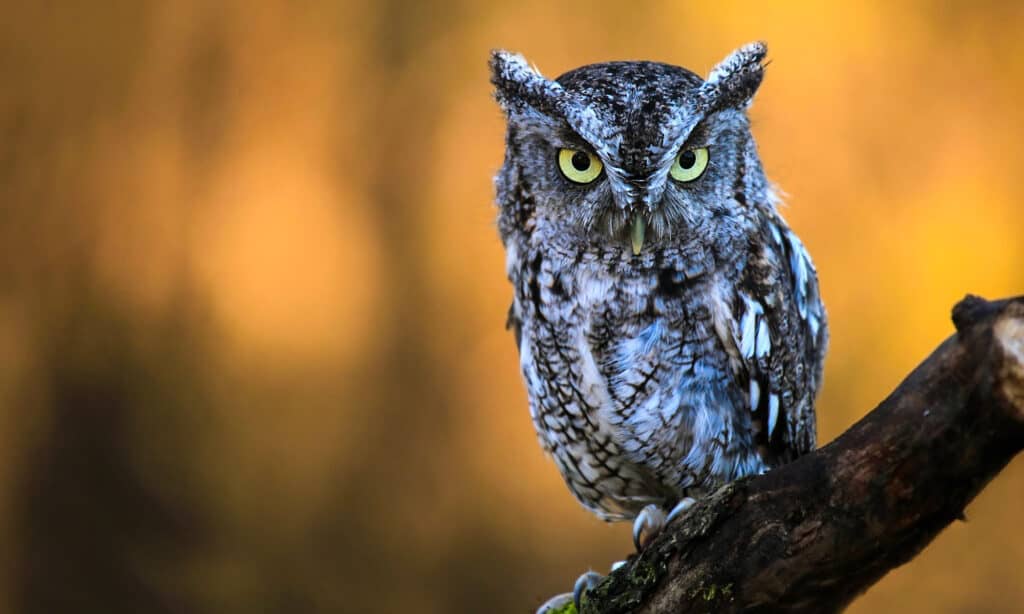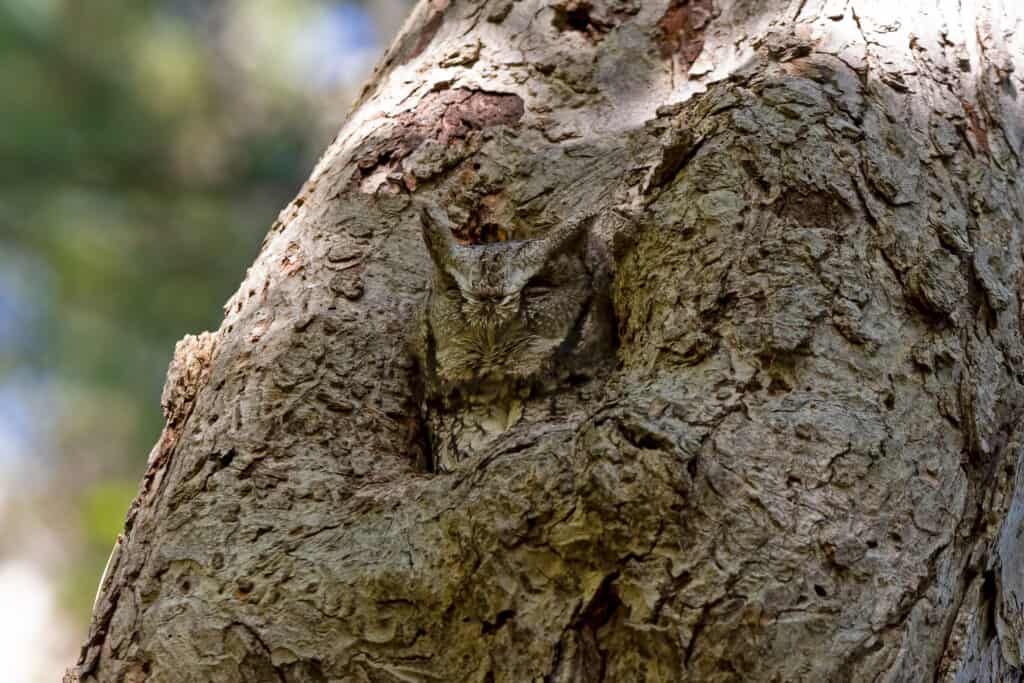Screech owls are fascinating creatures that have captured the interest of bird watchers and nature enthusiasts alike. These small, nocturnal birds of prey can be found throughout North America, living in a variety of habitats such as forests, woodlands, and suburban areas. One common question among those who admire these beautiful birds is: what do screech owls eat? In this article, we will explore the diet of screech owls and shed light on some interesting facts about their feeding habits. Whether you’re an avid birder or simply curious about these amazing creatures, read on to learn more about what makes screech owls so unique!
What is a Screech Owl?

Eastern screech owls and western screech owls look very similar and have a similar diet.
©mlorenz/Shutterstock.com
A screech owl is a small bird of prey that belongs to the Strigidae family. They are typically found in wooded areas throughout North and South America, and they have adapted well to urban environments as well. On average, they measure between 6-10 inches in length and weigh anywhere from 4-9 ounces.
Screech owls come in two color variations: red or gray. The red variety has a reddish-brown coat with white spots, whereas the gray variation has a gray-brown coat with black streaks. Both variations have large yellow eyes and ear tufts on their heads that resemble horns, which help them hear better.
These birds also have sharp talons for catching prey and curved beaks for tearing flesh. Overall, screech owls are fascinating creatures that play an important role in maintaining balance within their ecosystems.
What Do Screech Owls Eat?

Screech owls are nocturnal hunters and are rarely spotted by humans during the day.
©Amanda Guercio/Shutterstock.com
Screech owls are known to be opportunistic feeders, which means that they rely on a variety of prey items to sustain themselves. Their diet typically consists of small mammals such as mice, voles, shrews, and even birds like sparrows and finches. They also consume insects like moths and beetles.
When it comes to hunting, screech owls have excellent eyesight and hearing abilities that help them locate their prey in the dark. They are able to silently swoop down upon their unsuspecting victims while in flight or pounce on them from a perch. Additionally, these nocturnal predators use their sharp talons and beak to capture their prey with ease.
It is interesting to note that screech owls have been observed consuming larger animals than themselves on rare occasions when food is scarce. This behavior is known as “surplus killing,” where they kill more than what they can eat at once and store the excess for later consumption.
Overall, screech owls play an important role in maintaining ecological balance by keeping the populations of rodents under control.
Screech Owl Diet
| Number | What Do Screech Owls Eat? |
|---|---|
| 1 | Insects |
| 2 | Beetles |
| 3 | Moths |
| 4 | Crickets |
| 5 | Mice |
| 6 | Other rodents |
| 7 | Shrews |
| 8 | Bats |
| 9 | Birds |
| 10 | Lizards |
| 11 | Frogs |
| 12 | Spiders |
| 13 | Earthworms |
| 14 | Crayfish |
| 15 | Fish |
| 16 | Voles |
Habitat

Screech owls are cavity-nesting birds. They prefer to be a minimum of 10 feet off the ground.
©Kathryn Bedard/Shutterstock.com
Screech owls are known to inhabit a wide range of environments, including woodlands, farm groves, shade trees, and deciduous or mixed woods. However, in some areas, they may be absent due to the lack of dead snags with suitable nesting holes. These robin-sized nocturnal creatures have adapted well to human presence and can often be found in city parks or suburban yards without people being aware of their presence.
During the day, screech owls hide in holes or dense cover where they remain camouflaged from predators. They become active at nightfall when their keen sense of hearing and exceptional vision allows them to hunt small prey such as insects and rodents. While they are silent hunters, these birds make soft whinnies and trills throughout the night, which are characteristic sounds for those who know how to listen for them.
When it comes time for the breeding season each year, screech owls will typically mate with one partner for life. Both parents take turns incubating eggs that hatch after about a month’s time into fluffy young chicks that require constant care from both parents until they eventually fledge.
Overall, screech owls play an important role in maintaining healthy ecosystems by controlling populations of small animals like mice and insects while also providing entertainment for birdwatchers lucky enough to spot one during their quiet nightly rounds.
Nesting

Eastern screech owls are camouflaged right into the bark!
©Karen Hogan/Shutterstock.com
The courtship displays of male screech owls are intricate dances that involve raising wings, bowing down, and clicking their bills. These movements are designed to attract the attention of a female mate. Once a pair is established, the male will bring food to his partner as part of their bonding ritual.
Mated pairs also engage in preening each other’s feathers and calling in duets. This behavior strengthens their bond and prepares them for nesting season.
Screech owls typically nest in cavities found in trees, including natural hollows and abandoned woodpecker holes. They have also been known to use artificial nest boxes provided by humans. The nests are usually located 10-30 feet above ground level but can be found as high up as 80 feet.
Overall, these fascinating birds exhibit complex social behaviors during courtship and mating rituals while utilizing specific types of habitats for nesting sites.
Reproduction

Screech owls can lay up to 8 eggs in a clutch.
©mlorenz/Shutterstock.com
Screech owls are known to lay a clutch of 4-5 white eggs, although sometimes the number can vary from 2-8. The female is primarily responsible for incubation, and this process typically lasts an average of around 26 days. During this time, the male brings food to the female in order to support her while she sits on the eggs. He may also help bathe and groom her and is overall very attentive to his partner.
Once hatched, both parents take an active role in feeding their young. In fact, they may even bring back small blind snakes, which they release into the nest cavity, where they burrow through debris at the bottom of the cavity and feed on insects there. This behavior not only provides essential nutrition for growing chicks but also helps protect them from parasites that could be harmful or deadly.
After about four weeks following hatching, young screech owls will begin to leave their nests and explore their surroundings under parental supervision. Even after leaving their nest, young birds will continue to rely on their parents for some time as they learn how to hunt and fend for themselves in the wild.
In Flight
The screech owl is a sight to behold in flight. This small bird of prey has a steady wingbeat, clocking in at about five strokes per second. Unlike some other birds, the screech owl does not glide often while flying but instead relies on its powerful wings to maintain momentum. When navigating through wooded areas, this bird may use erratic movements to maneuver around trees and obstacles.
One notable feature of the screech owl’s flying style is its tucked-in head. By keeping their heads close to their bodies during flight, these birds create a more streamlined appearance that helps them move through the air with greater efficiency. The result is a somewhat stubby-looking bird that nonetheless manages to be incredibly agile and swift in flight.
Overall, watching a screech owl take off into the sky and soar above the treetops is truly a remarkable experience for any nature enthusiast or birder. With its broad wings and impressive aerial maneuvers, this tiny predator proves that sometimes big things really do come in small packages!
Incognito
Screech owls are highly skilled at avoiding detection when they feel threatened. In order to blend in with their surroundings and avoid being spotted by predators, screech owls will stretch out their bodies and tighten up their feathers to make themselves look like a branch. This camouflage technique is incredibly effective, as it allows the owl to blend seamlessly into its environment and avoid detection.
However, if the owl knows that it has been detected by a predator or other threat, it will quickly take flight in order to escape danger. Despite its small size, the screech owl is an agile and powerful flier, able to maneuver through trees and other obstacles with ease.
Overall, the incognito behavior of screech owls is just one of many fascinating aspects of these amazing birds. From their unique hunting techniques to their intricate vocalizations, there is much more to learn about these remarkable creatures.
Threats
The impact of livestock and livestock agriculture on screech owls is a complex issue that has been the subject of much research. One major threat to screech owl populations is habitat loss due to deforestation, which can occur when forests are cleared for grazing or crop cultivation. In addition to direct habitat destruction, these activities can also lead to changes in the availability of prey species that screech owls rely on for food.
Livestock feed production can have additional impacts on owl habitats through pesticide use, water pollution from runoff, and soil degradation from overgrazing. The use of antibiotics and growth hormones in animal husbandry may also contribute to the development of antibiotic-resistant bacteria that could affect both wildlife and human health.
Reducing meat consumption could have positive effects on screech owl habitats by reducing demand for land-intensive livestock farming practices.
Ultimately, protecting screech owl populations will require a multifaceted approach that addresses both habitat destruction and prey availability while promoting sustainable agricultural practices.
The photo featured at the top of this post is © mlorenz/Shutterstock.com
Thank you for reading! Have some feedback for us? Contact the AZ Animals editorial team.







